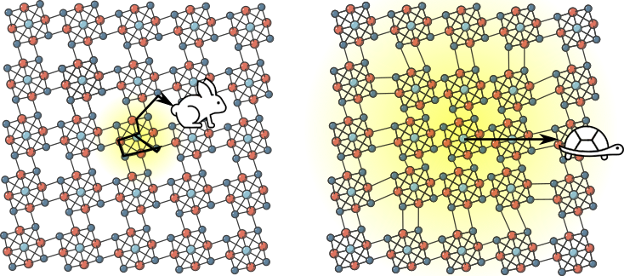Silicon (Si) is one of the most interesting elements listed in the periodic table. Silicon exists almost everywhere an Integrated Circuit (IC) exists; without it, we’d lose everything virtual about our world, alongside most of the tools we use to understand and operate on it. Silicon matters.
In contrast, Re6Se8Cl2 is a synthetic superatomic material: you can’t find it anywhere in the wild. Being superatomic simply means that the atomic elements within Re6Se8Cl2 behave like one big atom but actually manifest properties that are more than the sum of its elementary parts. Re6Se8Cl2 was manufactured in the lab of one of the paper’s collaborators, Xavier Roy.
Both silicon and us can rest easy for now, though, as we won’t have to refer to the chips inside our computers as being made of “Re6Se8Cl2” any time soon: Rhenium, the first element of the molecules that make up this new semiconductor material, is extremely rare on Earth (making it prohibitively expensive to manufacture at scale). Re6Se8Cl2 is more of a testbed for the electronics of the nebulous future and a Rosetta stone of sorts for behaviors, patterns, and physics that might be useful to get there (reaching a destination, in this case, implies having to run through the entire scientific process).
And Re6Se8Cl2 isn’t that different from other scientific breakthroughs in that the discovery of it being “the best semiconductor that we know of in terms of energy transport” came by… chance. It was meant to test the team’s super-resolution imaging tools due to expectations of slow electronic movement; however, when it showcased bullet-like speeds, the research priorities (appropriately) changed.
Superatomic Energy Transport (or how the tortoise beat the hare)
There are many layers to electrons and fundamental particles, some of which we’ve (very briefly) covered in explaining “What Is a Superconductor?.” But a good place to start is knowing that electrical current is the (relatively) ordered movement of electrons – without that ordered flow, no Power-On would work. Simultaneously, it’s these same electrons that we can ascribe states of information to ‘on’ and ‘off.’ One, and zero. No bits, and no bytes, and no Alan Wake 2.
Without electrical power, there’s no digital anything. Different materials conduct or superconduct electrons relatively better or worse: some with higher numbers of electrons wasted (as heat) as they travel from one point of the material to another, and some can even turn electrons into Cooper pairs, coordinating their movement in such a way that there’s no wasted energy: one facet of a phenomenon known as superconduction.
In silicon, particles known as excitons (electrons or electron-hole pairs) have the duty of carrying electrical current and information, and they do a good enough job of it: we’re breaching into quantum physics and supercomputers and new Intel and AMD CPUs and other useful forms of it, after all. But the new material, Re6Se8Cl2, is exotic: it allows for information to be carried on the back of a new quasiparticle called an acoustic exciton-polaron (as their name implies, quasiparticles almost became a particle, and their name refers to them being smaller than an atom). These exciton-polarons result from a strange interaction between the excitons within Re6Se8Cl2 (electrons or electron-hole pairs) and phonons (another type of fundamental particle that is created through the atomic structure vibrations of any material, including Re6Se8Cl2).
These quasiparticles, these exciton-polarons, have yet another very distinctive property: ballistics. Within Re6Se8Cl2, acoustic exciton-polarons filled with information zip ahead instead of scattering; they hit the mark, instead of dancing and wasting energy with “every” subatomic piece around it.

The hare is quick but slowed by its inability to keep a straight course. Ballistics – flying in a straight line without scattering – is the territory of the slow-but-steady tortoise. Slower does sometimes mean faster. Image credit: Jack Tulyag / Columbia University
Perhaps a good way of framing this is to imagine that electrons usually behave as if they’d been fired by a shotgun: the pellets scatter haphazardly, are pushed in different ways, and some even manage to bump against one another while they’re at it. Like electrons, they do get there eventually… while leaving some stray particles on the way, wasting energy in the process.
Exciton-polarons are more like a single-shot in that they follow their ejection path in a straight line. This is the key to how fast they are, and one we can empathize with; going straight towards our destination does tend to be the fastest way to get there. In doing so, the exciton-polarons managed to cross their material sample twice as fast as electrons typically cross silicon (crossing several microns of the sample in less than a nanosecond).
Interestingly, part of the reason that exciton-polarons are better and faster at ferrying energy than electrons in silicon derives from them actually being fundamentally slower. But how is it possible for a particle that moves slower than another to actually be faster than it? It all comes down to how the Re6Se8Cl2 excitons are ejected compared to their electron counterparts in silicon. Because they’re slower to eject, the excitons in Re6Se8Cl2 have a speed that’s actually closer to that of phonons (those particles that are created through the atomic structure vibrations of any material), allowing them to pair up and unlock the shortest available route to their destination. At slow enough exciton speeds, phonons can nimbly enter the passenger seat instead of hitting the car itself. And because exciton-polarons themselves are already moving slower than usual, they also get to avoid more of the usual roadblocks that silicon electrons can. Traffic does sometimes flow faster as it’s slowed down.
Outro
Exciton-polarons are currently expected to undergo further engineering so that they are capable of lasting as much as 11 nanoseconds. With that, the team estimates the quasiparticles could cross distances of 25 micrometers at a time – apparently enough for us to extract useable computation out of it.
The researchers say theoretical processing speeds (switching speed) of systems using exciton-polaron pairs can reach six orders of magnitude higher performance than the nanoseconds achievable in current Gigahertz electronics, breaching the femtosecond scale. And at least in the case of Re6Se8Cl2, all of that could happen at room temperature.
But once again, we must say it: unless we’re sitting on undiscovered mining veins of Rhenium (or we find those reserves somewhere in space a la Starfield), Re6Se8Cl2 isn’t a silicon killer. But it is an important piece in laying down our semiconductor futures. It remains to be seen what lessons learned here can be transferred to other particles, superatomic or not, that want to aid silicon in keeping our virtualities afloat.









